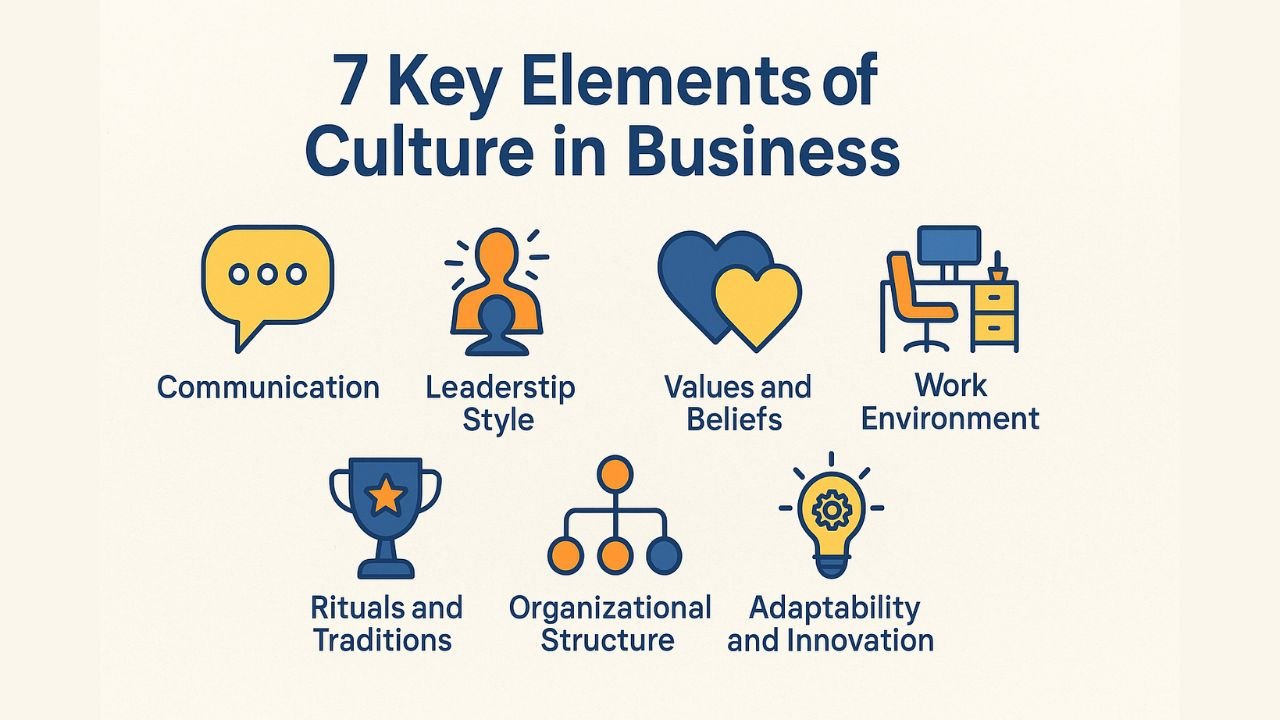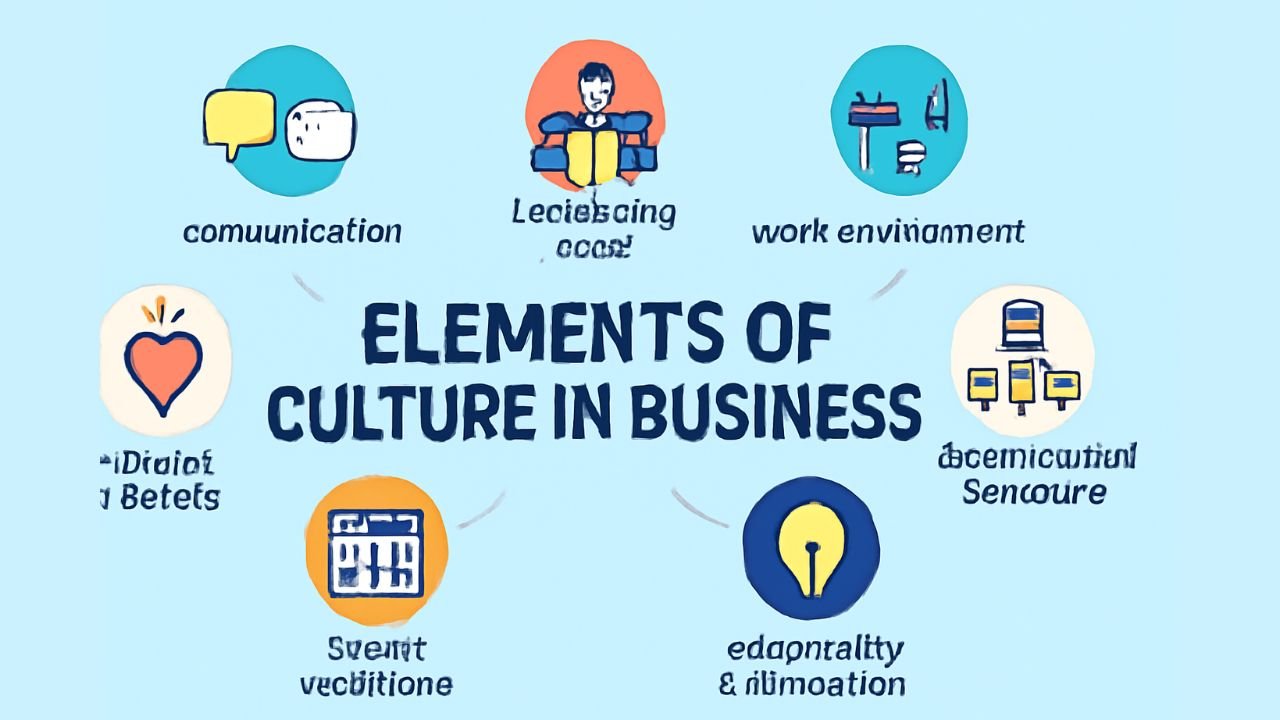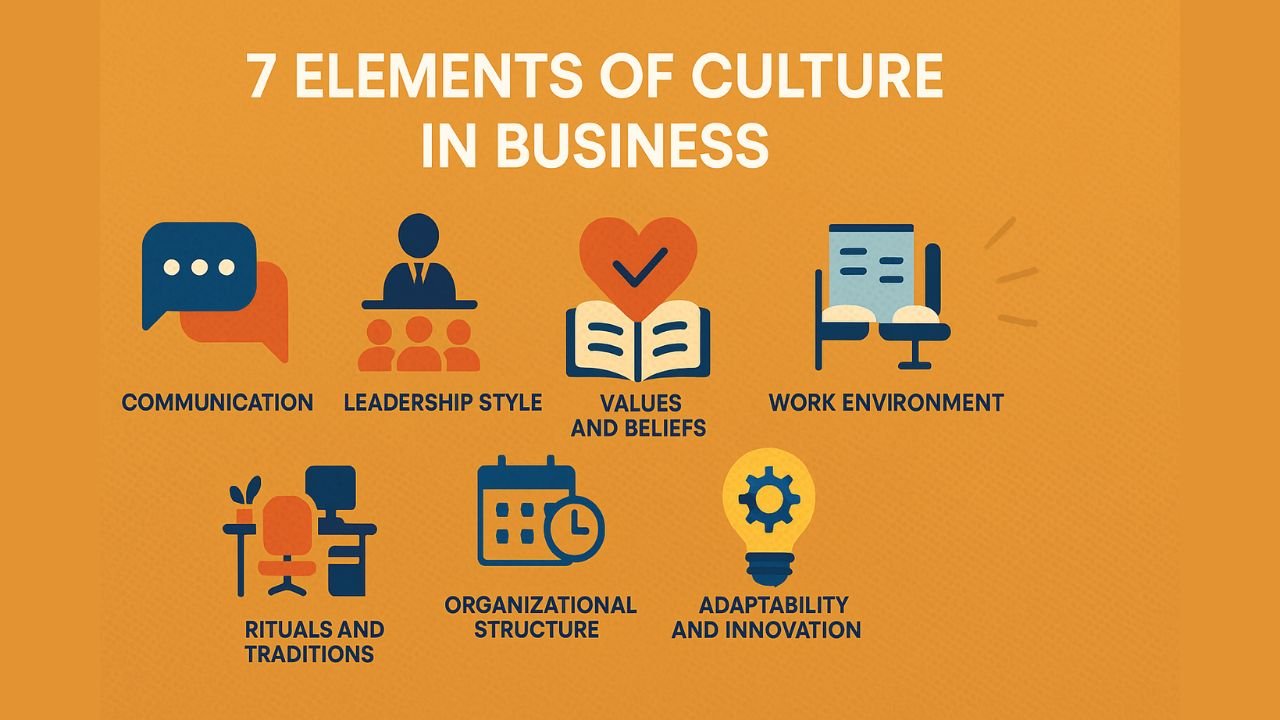In today’s fast-paced and interconnected global market, understanding the elements of culture in business has never been more crucial. The cultural landscape of an organization influences not only internal practices and behavior but also impacts its overall success. Whether you’re running a startup or managing a multinational corporation, knowing how cultural factors play a role in shaping your business environment can give you a significant competitive advantage.
This article will explore the seven essential elements of culture in business, providing insights, examples, and actionable tips to help you navigate and improve your organizational culture. Let’s dive in!
7 Key Elements of Culture in Business Every Leader Should Know

Understanding the elements of culture in business is essential for building a thriving, productive, and innovative organization. These elements shape how teams collaborate, make decisions, and contribute to business success. Here are the 7 essential elements that define business culture:
- Communication
- Effective communication is the backbone of any business. Transparent and clear interactions build trust and reduce misunderstandings within teams.
- Leadership Style
- The leadership approach sets the tone for the company’s culture. Whether it’s democratic, transformational, or autocratic, leadership shapes employee engagement and motivation.
- Values and Beliefs
- Core values guide decisions and behaviors. Aligning personal values with company beliefs fosters unity and a shared purpose.
- Work Environment
- The physical and emotional atmosphere plays a critical role in employee satisfaction and productivity. A positive work environment enhances creativity and teamwork.
- Rituals and Traditions
- Regular rituals, like recognition programs or team-building activities, create a sense of community and reinforce company values.
- Organizational Structure
- A well-organized structure ensures clear roles and responsibilities, which enhances efficiency and accountability in day-to-day operations.
- Adaptability and Innovation
- An innovative mindset and adaptability to change help companies stay ahead in a competitive market. Embracing new ideas leads to growth and success.
Pro Tip: Ensure you integrate these elements to cultivate a strong business culture that drives performance, boosts employee satisfaction, and enhances overall success.
👉 Check out our post on PedroVazPaulo Coaching & Consulting: Executive Business Solutions That Drive Success for more insights.
The Elements of Culture in Business
Culture is the collective behavior, values, beliefs, and practices that characterize a group or organization. In a business context, culture sets the tone for how employees interact with each other, make decisions, approach challenges, and align with the company’s mission.
The elements of culture in business are often subtle but immensely powerful. They influence everything from how employees feel about their work to how effectively a company can adapt to change. As a business leader, understanding these elements enables you to cultivate a positive, productive work environment and foster strong relationships within your team.
In this article, we will explore the seven elements that constitute the culture in any business environment. These elements shape the foundation of an organization’s identity and play a critical role in determining its long-term success.
1. Communication
Communication is the cornerstone of any thriving business. How an organization communicates internally and externally has a direct impact on its efficiency, employee satisfaction, and client relationships.
In a business setting, communication encompasses both verbal and non-verbal aspects. It includes everything from emails and meetings to body language and the way employees share ideas. Open, transparent communication fosters trust and reduces misunderstandings, while poor communication can lead to confusion, conflict, and missed opportunities.
Examples of Good Communication in Business:
- Regular Check-ins: Having regular team meetings and one-on-one check-ins to ensure everyone is aligned with the company’s goals.
- Clear Guidelines: Creating easily accessible resources that outline the company’s communication expectations, such as email etiquette or messaging platform usage.
- Feedback Loops: Encouraging constructive feedback from all levels of the organization to improve processes and performance.
Tip: To improve communication within your company, consider investing in tools that streamline information sharing, like project management software or internal chat platforms.
2. Leadership Style
The leadership style adopted by an organization greatly influences its culture. Leaders set the tone for how employees interact with each other and make decisions. Whether a business has an autocratic, democratic, or laissez-faire leadership style will shape the work environment in unique ways.
In organizations with strong, proactive leadership, employees tend to feel more motivated and supported, knowing that their leaders are invested in their success. Alternatively, weak or inconsistent leadership can lead to confusion, low morale, and high turnover rates.
Types of Leadership Styles:
- Autocratic Leadership: Leaders make decisions without input from employees. This can work well in times of crisis but can lead to disengagement if used excessively.
- Democratic Leadership: Employees are encouraged to participate in decision-making. This can foster a collaborative and innovative work environment.
- Transformational Leadership: Leaders inspire and motivate employees to exceed expectations by focusing on vision, personal development, and motivation.
Example: A company that adopts a transformational leadership style encourages employees to contribute their ideas and take initiative, fostering innovation and creativity.
Tip: Choose a leadership style that aligns with your business goals and values. Adapt your approach based on the needs of your team.
3. Values and Beliefs
Core values and beliefs are the foundation of any business culture. These values define what is important to an organization, whether it’s integrity, customer satisfaction, or innovation. The beliefs shared by employees shape how they approach their work, collaborate with others, and contribute to the company’s overall mission.
Examples of Core Values in Business:
- Integrity: A commitment to doing the right thing, even when no one is watching.
- Customer Focus: Prioritizing the needs and satisfaction of customers above all else.
- Innovation: Continuously seeking new ways to improve products, services, and processes.
Tip: Clearly define your organization’s core values and ensure they are communicated regularly. Use them as a guiding compass for decision-making and employee behavior.

4. Work Environment
The physical and emotional atmosphere in which employees work plays a critical role in shaping business culture. A positive work environment fosters productivity, collaboration, and employee well-being, while a toxic environment can lead to burnout, disengagement, and high turnover.
Key Aspects of the Work Environment:
- Office Layout: Open offices versus cubicles, quiet spaces for focus work, or collaborative zones for brainstorming.
- Employee Benefits: Offering wellness programs, flexible work hours, and mental health support.
- Team Dynamics: The degree of collaboration versus individual work, and how teams are structured within the company.
Example: A company that prioritizes work-life balance and provides remote work options will likely cultivate a culture of trust and flexibility.
Tip: Regularly assess the physical and emotional environment of your workplace to ensure it promotes well-being and supports the company’s goals.
5. Rituals and Traditions
Rituals and traditions are the repetitive, everyday practices that define a company’s culture. These can include annual company events, monthly team-building activities, or daily rituals like team huddles or “coffee breaks.”
These rituals and traditions not only create a sense of community within the workplace but also reinforce the core values of the organization.
Examples of Rituals and Traditions:
- Employee Recognition Programs: Celebrating employee milestones, such as work anniversaries or achievements.
- Team Bonding Activities: Hosting regular team-building events or social activities to strengthen relationships.
- Quarterly Celebrations: Recognizing quarterly successes or reviewing company goals with a celebration.
Tip: Create or maintain rituals that reinforce your company’s core values. Make sure they are inclusive and aligned with your organizational objectives.
6. Organizational Structure
Organizational structure defines how a company’s hierarchy is organized and how authority and decision-making flow. A company’s structure can influence communication patterns, collaboration, and accountability. The structure can range from flat to hierarchical, each with its own benefits and challenges.
Types of Organizational Structures:
- Hierarchical: Clear levels of authority and decision-making, often seen in large companies.
- Flat: Few or no levels of management, promoting open communication and quicker decision-making.
- Matrix: Combines functional and project-based structures, fostering collaboration across departments.
Example: In a flat organization, employees are often empowered to make decisions, which can lead to faster innovation but might lack clear accountability.
Tip: Choose the organizational structure that fits your company’s size, goals, and culture. Flexibility and adaptability are key to success.
7. Adaptability and Innovation
In the ever-changing business world, adaptability and innovation are key components of a strong culture. Organizations that embrace change and continuously look for innovative ways to improve are more likely to thrive in the long term.
Encouraging creativity, staying ahead of industry trends, and fostering a growth mindset within your team all contribute to a culture that values innovation.
Example of Innovation in Business:
- R&D Departments: Investing in research and development to create new products or services.
- Employee Innovation Programs: Encouraging employees to submit ideas for improvement or new product concepts.
Tip: Create an environment where experimentation and creative thinking are welcomed. Offer resources and time for employees to explore new ideas.
🔗 Explore more visit Time Capsule USA
FAQs:
What are the 7 elements of culture in business?
The 7 elements of culture in business include communication, leadership style, values and beliefs, work environment, rituals and traditions, organizational structure, and adaptability.
How does leadership affect business culture?
Leadership plays a key role in shaping business culture by setting the tone for communication, decision-making, and employee behavior, influencing morale and performance.
Why is adaptability important in business culture?
Adaptability ensures that businesses can respond to changing market conditions, innovate, and stay competitive, which is vital for long-term success.
What role do values play in business culture?
Core values define a company’s identity, guide behavior, and set expectations for employees, fostering alignment with the organization’s mission and goals.
How can businesses improve their culture?
Businesses can improve their culture by promoting clear communication, embracing innovation, fostering strong leadership, and ensuring a supportive work environment.
Conclusion: Building a Strong Culture with the 7 Elements
The elements of culture in business are interwoven and essential to creating an environment where employees are motivated, collaborative, and innovative. By understanding and nurturing these seven elements—communication, leadership style, values, work environment, rituals, organizational structure, and adaptability—you can create a business culture that fosters growth, success, and employee satisfaction.
As a business leader, it’s important to continuously evaluate and refine these elements. Use them to guide decision-making, improve employee engagement, and drive organizational success.
Call to Action: Ready to build a stronger business culture? Start by assessing your company’s current culture and identifying areas for improvement. Implement strategies that align with your core values, and watch your business thrive!









